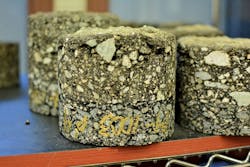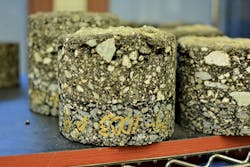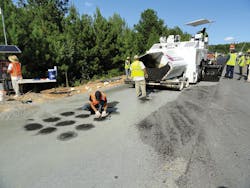Renewed strength
Pavement recycling is a term that encompasses several cost-effective and environmentally conscientious asphalt pavement rehabilitation processes.
These processes include cold in-place recycling (CIR), cold central plant recycling (CCPR) and full depth reclamation (FDR). Working within the upper 2 to 6 in. of the bound layers, CIR can be used to restore near-surface-to-mid-level deterioration. When deeper distresses are encountered, FDR is effective at producing a stabilized foundation by incorporating both bound and unbound layers at a typical thickness range from 8 to 16 in. Reclaimed asphalt pavement (RAP) from new millings or existing stockpiles of RAP can even be used to place single or multiple recycled layers using CCPR, yielding a product equivalent to that of CIR.
The Virginia Department of Transportation (VDOT) has garnered a reputation for pushing boundaries when it comes to delivering large and complex pavement recycling projects. Much of the background knowledge for doing so has come from its research division, the Virginia Transportation Research Council (VTRC) located in Charlottesville.
Excellence in action
In 2011, VDOT completed construction on a section of I-81 using FDR, CIR and CCPR. The FDR was produced using a combination of portland cement and lime-kiln dust while the CIR and CCPR were produced using foamed asphalt and portland cement. VDOT contracted the reconstruction work, because this section of interstate was being continually repaired in an effort to address deterioration deep within the pavement structure. VDOT chose pavement recycling because it has been shown to reduce costs, reduce environmental impacts and speed up the construction time. VTRC is continuing to monitor the performance of the I-81 project to document the condition of this recycling project that carries more than 6,400 trucks each day. The performance assessment information is helping VDOT and other agencies show that pavement recycling is effective even in high truck-volume locations.
VTRC most recently surveyed the performance of the I-81 project in the summer of 2016. At the time of the performance survey, the project had carried approximately 10 million equivalent single-axle loads (ESALs) in the right lane. The average rut depth and ride quality (in terms of the International Roughness Index [IRI]) in the right lane were measured as approximately 0.1 in. and 44 in. per mile, respectively. According to VDOT criteria, the ride quality is “excellent” and has been since construction.
During construction of the I-81 recycling project, researchers from VTRC collected samples for materials characterization testing in the lab and documented the construction processes. Ideally, the researchers would have liked also to instrument the pavement with pressure and strain sensors to quantify the response to truck loading. In 2012, an opportunity arose that allowed the researchers to fill in this critical gap.
Core samples labeled for materials comparison and analysis.
Trucking through
In 2012, the year after completing the I-81 project, VDOT secured three track sections at the National Center for Asphalt Technology (NCAT) Test Track (www.ncat.us) to study the performance of three designs using pavement recycling. A 5-in.-thick layer of CCPR was used in three track sections and was produced using foamed asphalt and portland cement. Millings from the I-81 project were trucked to Alabama from Virginia and were used as the source material for the CCPR mixture. The CCPR mixture had a ½-in. nominal maximum aggregate size. Two sections contained CCPR over the existing aggregate base with two different asphalt overlay thicknesses (6 in. and 4 in. for sections N3 and N4, respectively) while the third section (S12) included CCPR over an FDR base with a 4-in. asphalt overlay. The 8-in. FDR foundation was produced when the existing aggregate and subgrade material were stabilized with hydraulic cement.
The work at NCAT is advantageous in that the traffic loading is accumulated quickly; the ESALs experienced over five years on I-81 were experienced at NCAT in only the first two years. Additionally, the NCAT sections include instrumentation which can quantify the pavement response before deterioration is evident at the surface and allow the study of changes in response over time. Following the performance after the first test cycle, a second 10-million-ESAL testing cycle was initiated in 2015 and will continue through October 2017.
After more than three years of trafficking and more than 15 million ESALs, the three recycled test sections confirm the excellent performance of the recycled designs. No deterioration has been observed at the surface for any of the three sections. The average rut depth within the three sections ranges from approximately 0.2 in. to 0.3 in. While this performance is certainly impressive, perhaps the most remarkable behavior has been that of the section having the FDR foundation. The ride quality has been nearly unchanged since the start of testing. The strain measured at the bottom of the CCPR layers, while increasing for the sections having an aggregate base, was found to decrease over time for the section with the FDR foundation when the effects of temperature were normalized. This is most likely due to the continued curing of the cement-stabilized FDR layer. The measured strain values were similar to those sections tested in previous track cycles for perpetual performance and whose life spans exceeded 30 million ESALs.
When considering the entire pavement structure for section S12, the combination of an FDR foundation, CCPR base layers and RAP in the surface layers gives a total recycled content of approximately 80%. The test results to date suggest that a reconstructed or even newly constructed pavement can be built using a very high recycled content (when considering the entire pavement structure) and still have excellent performance. While the work on VDOT’s sections at the NCAT Test Track are ongoing, VDOT is looking for ways to implement what has already been learned.
Continued success
In late 2017 VDOT will again return to the interstate for another major pavement recycling project. Interstate 64 is an east-west corridor that runs like a belt through the middle of Virginia. The portion between Richmond and the Hampton Roads region varies between a four- and a six-lane divided highway. For just over seven miles near Virginia’s historic triangle of Jamestown, Williamsburg and Yorktown, the existing four-lane divided highway will be reconstructed and a new travel lane and full-width shoulder will be added in both directions. Pavement recycling will play a prominent role in this work.
This section of I-64 was originally constructed in the 1950s and consists of jointed reinforced concrete pavement on a cement-treated soil foundation. The pavement currently exhibits distresses such as faulting and deteriorated joints and has experienced many efforts to restore the ride quality. A decision was made to replace the existing pavement along with widening the outside shoulder to 12 ft and adding a new travel lane and 12-ft-wide inside shoulder. VDOT originally prepared two designs for this reconstruction/rehabilitation effort; one that included an asphalt pavement built on a stabilized aggregate base and one that included a concrete pavement built on a stabilized aggregate base. About this time, researchers from VTRC proposed a design based on pavement recycling concepts applied on I-81 and further studied at NCAT’s Test Track. Considering the significant cost savings, the recycled design was selected as the primary design and a contract using the recycled approach was awarded at the beginning of 2016.
When the I-64 project starts running at full steam in 2018, traffic will continue to use the two existing lanes. The new left lane and left shoulder will be constructed using a 12-in. cement-treated aggregate foundation followed by a 6-in. base course of CCPR. Once the two courses of surface asphalt having a total thickness of 4 in. are added, traffic will be shifted to the new lane and shoulder and the existing pavement will be removed. The existing aggregate and subgrade will be stabilized to a depth of 12 in. using a reclaimer, similar to an FDR process. On top of this, a 6-in. base course of CCPR will be placed. Once the two courses of surface asphalt having a total thickness of 4 in. are added, the rebuilt roadway will consist of three new travel lanes and two shoulders having a total width of 60 ft.
VDOT has a high degree of confidence in the recycled design based on the results of testing at the NCAT Test Track. Section S12, which is slightly thinner than the design recommended for the I-64 project, has carried more than 15 million ESALs to date and shows no signs of giving up any time soon. With the anticipated traffic on the I-64 project, it will take approximately 19 years to reach the same level of truck loading.
The awarded contract includes approximately 345,000 sq yd of stabilized base produced using the FDR process with another 168,000 tons of CCPR. VTRC estimated that using the recycled design on this project will save approximately 36% in terms of the square yardage price at the same structural capacity as the original pavement design and save VDOT more than $10 million.
A VTRC researcher collects samples for materials characterization testing, in order to help document construction practices.
The RAP wrap-up
Stockpiles of RAP occupy valuable space on contractor and DOT lots across the country. In Virginia, RAP “mountains” are becoming burdensome issues especially in the urban areas in the eastern side of the state where milling and inlays are prevalent forms of pavement rehabilitation. If a highway agency limits the RAP content of a surface mixture to 30% (or less), replacing a milled layer with an equivalent thickness of resurfacing results in an accumulation of the remaining 70% (or more) of the milled material (assuming the RAP is immediately reused). In many cases, highway agencies are taking the RAP that they cannot put back into their pavements for other uses such as fill or other non-structural applications, reducing the potential benefit of the RAP as a pavement resource.
In addition to pavement rehabilitation, Virginia’s pavement network is growing a few tens of miles per year. Most of this growth comes from lane additions and from construction of new subdivisions (VDOT is responsible for all state, county and local roads in 93 of its 95 counties). CCPR could be used to produce the majority of these pavement structures, thereby efficiently employing recycled materials in new pavements.
Where we go from here
VDOT is continuing to look for ways to include pavement recycling on its pavement rehabilitation projects. Findings from field research using CCPR have opened another avenue for VDOT to use recycled materials even when constructing new projects or new lanes. These findings also have shown the presence of a stabilized foundation, such as that obtained when using FDR, can provide significant benefits to the life of the pavement structure. VDOT anticipates continuing to experience significant benefits from using pavement recycling techniques, including reduced costs and reduced environmental impacts.


